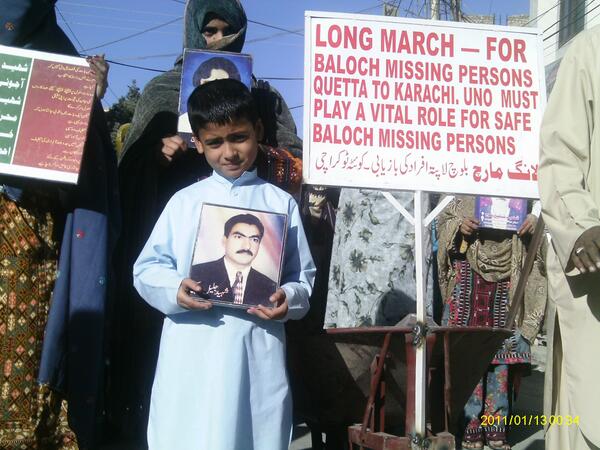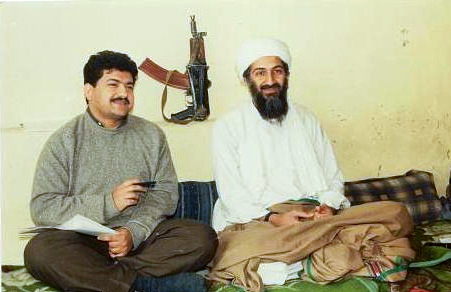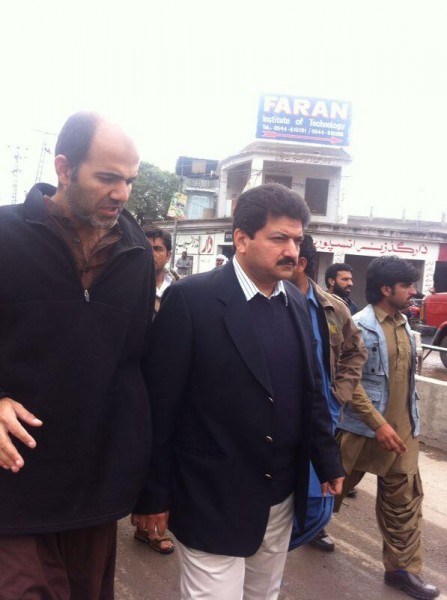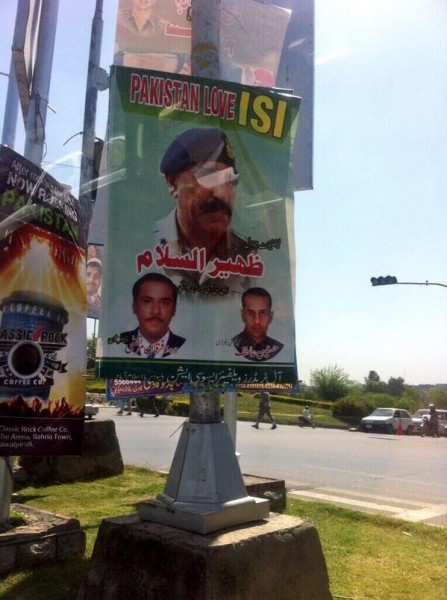
In Quetta city, a boy holds an image of his father Jalil Reki, one of Balochistan's missing people, at the beginning of a protest that marched through Pakistan over 5 months. Tweeted by journalism student and activist @FaizMBaluch
A man was shot six times. Bullets went through his ribs, pierced his stomach, his thighs, and his hand.
I can’t say for sure that Hamid Mir, Pakistan’s most prominent TV newsman, was shot by the Pakistan military’s intelligence wing, Inter-Service Intelligence (ISI) or proxies acting on their behalf.
And neither can Mir’s employer of the last 12 years: Pakistan’s leading news channel Geo. Yet they broadcast Mir’s brother Amir Mir making an emotional, bitter and strongly-worded accusation against the military and ISI. The New York Times reported the story with the headline “Critic of Pakistan Military wounded in Karachi attack”.
The many people in Pakistan who are sharing memes that vilify Mir, calling him an Indian spy or puppet and tweeting their unconditional support for the country’s armed forces and spies, also cannot know with certainty who shot Mir.
But there is a good reason for suspicion. Mir has been receiving threats from individuals whom he calls the ISI within the ISI. For the past few weeks he has been very vocal about a topic on his popular news show that the Pakistan military and the ISI don't want anyone to discuss: their ugly role in the war in Balochistan.
According to the Human Rights Commission of Pakistan (HRCP), since 2010 the bodies of hundreds of Balochistan’s “missing people” have turned up bearing torture marks. In 2013 alone, 116 bodies were found across the province, 87 of which were identified by families who accused Pakistan’s security agencies of abducting their loved ones.
Fight the frame
The international media explains Mir's attack in the context of a larger story about Pakistani journalists at risk and the big bad Pakistani military. This angle explores the conflict between Mir's TV station Geo and most of the country's media, nationalists and the military.
It seems to me that the frame of media one-upmanship misses the real story, and a likely motive for the attack: the missing people of Balochistan.
Mir knew the risks of speaking out on Balochistan. Pakistan’s media avoided the subject for years. So did Mir.
The Pakistani media’s silence on Balochistan stems partly from self-censorship due to fear of the military, partly from a nationalist stance that treats silence as patriotism, and partly because few really understand what is going on in the southwestern province.
Balochistan’s foggy war
Pakistan's national media organizations such as Mir’s Geo employ only a few people in Balochistan. It is the country's largest and most resource-rich province, and also least populated and poorest. Insurgencies have been brewing and cooling here for decades. The government restricts media access for international journalists. These factors help explain why covering Balochistan is complicated and dangerous, and why reporting about the province is rare.
When did this insurgency become a war? I can’t say for sure, but some very smart people think it happened when the Pakistani state bombed and killed the most prominent face of the insurgency, 79-year old Nawab Akbar Bugti, in 2006.
Facts about the Balochistan war are hard to verify. Armed Baloch nationalists are seeking independence from Pakistan, and Pakistan's armed intelligence operatives are trying to suppress them, sometimes through extrajudicial means. The government maintains that separatists are funded by “outside forces,” which is a euphemism for India.
Various sectarian and Islamist militias also use the area for recruitment and training to fight wars in Iran and Afghanistan, which border Balochistan, and within Pakistan itself.
Sometimes these groups join forces in pursuit of money and resources. The result is the people living in Balochistan have to protect themselves from several different dangerous ideologies.
Some Baloch nationalists are trying to drive all non-Baloch and the Pakistan military out of the province. Military convoys are often bombed. Punjabi families who have lived in Balochistan for decades are now unwanted “settlers”; hundreds have been killed and thousands forced to flee the violence.
Organized sectarian militants are also killing the ethnic Hazara, who are Shia Muslims, and probably the largest casualty in this war. They are one of the largest non-Baloch groups in the province. Thousands have been killed since 2009 in attacks which have a level of sophistication that is outside the capability of Baloch insurgents.
The most under-reported element of this war is that Baloch men are being picked up by intelligence operatives. Respected journalist Mohammed Hanif detailed the plight of the families in a pamphlet published by the HRCP in 2012. Excerpts appeared in a few English dailies in Pakistan, but a larger discussion never ensued.
These families hope their missing sons and husbands will return. Too often, instead, tortured, lifeless bodies are dumped outside their homes. Unmarked graves appear years later; evidence of their deaths offers closure but not justice.
Mir, spies and the Baloch
Mir has recently become a vocal and persistent advocate for the missing and their families on his TV show. This might have gotten him into lethal trouble with the ISI.
Fifteen years ago, Mir had strong ties with the ISI and trusted relationships with the Taliban. His links to both groups allowed him to swing the last known interview with Osama bin Laden after 9/11. Those relationships evidently went sour. In 2010 he accused his former friends at the ISI of framing him for incitement to murder. In 2012 he blamed the Taliban for an attempt on his life.

Hamid MIr interviewing Osama bin Laden. From Wikimedia Commons CC-NC-2.0
What made Mir speak out now? Maybe he was moved by Mama Qadeer, a 72-year-old man who organized the families of other missing Baloch in a five-month, 2000-kilometer march from Balochistan’s capital city Quetta through the rest of Pakistan.

Hamid Mir joined the Long March on February 22 at Jhelum city. Photo tweeted by International Voice for Baloch Missing Persons Twitter account @IVBMP
Qadeer organized this unprecedented protest in an attempt to focus attention on his cause. He claims his son Jaleel was killed while in custody of intelligence agents in 2009. His advocacy now aims to help others whose sons have vanished get closure or justice.
On February 25, in a leading English-language daily, Mir urged the government to help recover Balochistan's missing people. The story, titled 72 year-old Mama Qadeer Baloch breaks record of Gandhi after 84 years, focused on the length and duration of the protest march, with the hope that the comparison would bring attention to an issue that has been systematically downplayed in the media.
Maybe Mir feels an affinity with the people of Balochistan because like him, they are now threatened from all sides. Like most Pakistani journalists who have been covering the not-so secret war in Pakistan’s northwest between the Taliban and the military, Mir was feeling increasing hostility and threats from his sources in the Taliban and the ISI.
Spies and intimidation
Pakistan's Ministry of Defence has petitioned the country’s broadcast regulation authority to cancel Geo's broadcast license. As I write this, Geo has voluntarily been made ‘less accessible’ by cable providers in most areas under army control or influence. Since Pakistan’s military owns or runs the largest property development companies in the country, Geo now risks being extensively censored across Pakistan.

“Pakistan Love ISI” poster with a headshot of ISI's chief on Constitution Avenue in Islamabad. Photo tweeted by former ambassador Husain Haqqani @husainhaqqani
The ISI has been increasingly aggressive and sloppy when dealing with journalists whose reporting assails its reputation. In 2011, journalist Saleem Shahzad's tortured body was found a week after he wrote a sensational story claiming links between Islamist militants and the armed forces. Before he disappeared he had received threats from the ISI.
Mir’s vocal stance in support of the rights of individuals being targeted by the state, by Islamist militants, and by others who resort to violence to further their political goals in Pakistan has nearly lost him his life.
It has also definitively placed him in opposition to those forces. We may not know who shot Hamid Mir, but we do know that the list of people willing to pick up a gun to get what they want in Pakistan is long. Mir was fortunate to escape with his life. But the battle for the rights of the missing in Balochistan is just beginning.
Sahar Habib Ghazi is a journalist who lives between Pakistan and the US. She worked at Geo TV 2005-2006. Sahar is currently the Deputy Editor at Global Voices. You can find her on Twitter @saharhghazi








13 comments